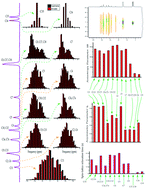Determination of chemical shift anisotropy tensor and molecular correlation time of proton pump inhibitor omeprazole by solid state NMR measurements
Abstract
The correlation between the structure and dynamics of the proton pump inhibitor omeprazole is portrayed by extracting chemical shift anisotropy (CSA) parameters through the 13C 2DPASS CP-MAS SSNMR experiment, site specific spin–lattice relaxation time by Torchia CP experiment, and calculation of the molecular correlation time. Omeprazole has a chiral structure centered at the sulfur atom between the pyridine and benzimidazole rings. The C2 and C8 atoms are connected with the sulfoxide bond, whose electronic environment influences the activity against P. falciparum in vitro. Both isotropic and anisotropic chemical shifts of C2 are substantially higher than those of the C8 nuclei. The presence of “nucleophilic suction pumps” creates a deshielding effect on the C2 nuclei. On the contrary, the shielding effect on the C8 nuclei is created by the pyridine ring with strong magnetic susceptibility. The CSA parameters of the carbon nuclei that reside on the pyridine and benzimidazole rings are higher than the carbon nuclei that reside on the methyl and methoxy groups. The presence of hydrogen bonding and the existence of π-electrons on the pyridine and benzimidazole rings are the reasons for the higher values of the CSA parameters. The dimeric structure is formed by two centrosymmetric omeprazole molecules by the action of intermolecular hydrogen bonding. The dimeric structure is stabilized by van der Waals contacts between the pyridine ring of one molecule and the benzimidazole ring of another. The benzimidazole ring also forms stacking interactions with another centrosymmetric molecule. All these interactions are responsible for the robust structure of the molecule and this is considered as the reason for the higher values of the spin–lattice relaxation time and the molecular correlation time of the central molecular framework compared to the peripheral molecular fragments. This atomic scale resolution of the structure and dynamics of such a valuable drug will illuminate the way for discovering advanced medicines.



 Please wait while we load your content...
Please wait while we load your content...